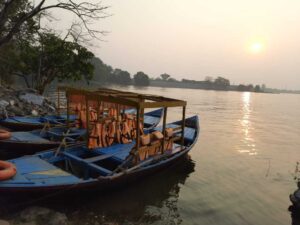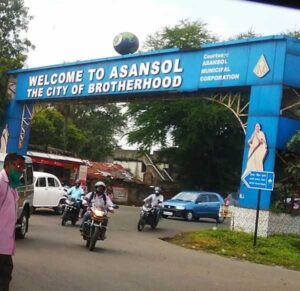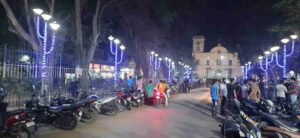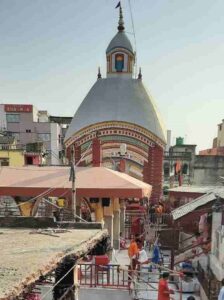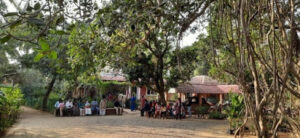Kazi Nazrul was born on 24 May 1899 in the village of Churulia, Asansol, Paschim Bardhaman district of the Bengal Presidency (now in West Bengal, India). The national poet of Bangladesh was a rebel who raised his voice against religious intolerance, injustice, and oppression in every sphere of life through his compositions. For his fierce activism earned him the title of Bidrohi Kobi (Rebel Poet).
On Jaistha 11(English month May), the birth anniversary of the poet, every year a full week festival is organized in the Churulia.
His father was the imam and keeper of the local mosque. The poet spent his childhood living in poverty. At the age of ten, he lost his father. To support his family, he worked as a caretaker and muezzin of the mosque.
Nazrul used to live in a mud house with a thatched roof in Churulia. Today, at the place of his home stands a two-storey building. His house transformed into a museum, Nazrul Academy, which houses the rare photographs and items used by him and the family members. His nephew Reazul Karim lives in the house. He is the secretary of the Nazrul Academy.
 |
| Nazrul Academy Churulia |
Nazrul and his sons used Kurta, his wife’s saree, his gramophone, chair, books, awards, and rare photographs are there in the museum.
The best item of the museum is copies of Nazrul’s handwritten poems.
Next to the Academy, a Nazrul library is there. The school of Nazul, Churulia Nazrul Vidyapith, is in the same lane. Established in 1870, the school is expanded to a larger area.
 |
| Kazi Nazrul School, Churulia |
Unable to continue paying fees, Nazrul left his school and joined a rural theatrical group. That was his first experience of poetry, drama, and literature. For livelihood, he worked at a bakery and tea stall in Asansol.
At the age of eighteen, he did not appear for the matriculation examination and joined the British Army. This stint of fewer than three years in the Army influenced the poet greatly. That experience enriched his thoughts, and the exposure made him aware of the happenings around the world.
During this period, Nazrul read extensively the works of Rabindranath Tagore, Sarat Chandra Chattopadhyay, together with the Persian poets Hafez, Omar Khayyam, and Rumi.
At that time, the country was under colonial rule, and the non-cooperation movement, the first mass nationalist campaign of civil disobedience against the British, was in the full-wave. The unbearable poverty and the oppression of the motherland made the poet desperate to get freedom.
The poet called for revolution through his works in his publication Dhumketu (The Comet). He achieved fame in 1922 with his most famous poem Bidrohi (The Rebel) and Bhangar Gaan(The song of destruction).
He established himself as a journalist in Kolkata. The agony of injustice, oppression, and exploitation reflects in all his literary works.
Nazrul encouraged people to agitate against British rule and joined the Bengal state unit of the Indian National Congress. He was put in prison on the charge of sedition by the British authorities. Many works of Nazrul were banned.
In prison, too, The rebel poet embarked on a hunger strike to protest against inhuman torture meted out on him. At that time, Kobiguru Rabindranath Tagore sent a telegram to ailing Nazrul to break his hunger strike.
The imprisonment did not stop him from writing. His attack against unjust and injustice became more vigorous.
During his visit to Cumilla, a city in the Chittagong Division of Bangladesh, in 1921, Nazrul met a young Bengali Hindu woman, Pramila Sengupta, with whom he fell in love. After a few years of relationship, they got married on 25 April 1924.
The couple faced a lot of social hostility from the orthodox Hindu and Muslim leaders. Muslim religious leaders criticized Nazrul for marrying a non-Muslim without converting her. Even the reformist Brahmo Samaj criticized Pramila, a member, for marrying a Muslim.
But, Nazrul was an exponent of humanism. The poet was secular to his core and gave his sons name with a mix of Hindu and Muslim names: Krishna Mohammad, Kazi Sabyasachi, Kazi Aniruddha Arindam Khaled (Bulbul).
He wrote several poems on the theme of unity between Hindus and Muslims. Projecting secular a part of Bengali literature is one of his vital contributions to the Banglasphere.
Nazrul was against the unequal treatment of women. Nazrul’s poems strongly emphasized the equal contribution of women to society.
When his wife Pramila fell seriously ill in 1939, he mortgaged the royalties of his gramophone records and literary works for his wife’s medical treatment. The picture of him taking care of his sick wife is there in the museum at Churulia.
Nazrul was not just a rebellion but also brought a revolution in Bengali poetry. He extensively enriched ghazals in the Bengali language. Nazrul wrote and composed music for thousands of songs, collectively known as Nazrul Geeti.
 |
| Buy Here: Nazrul Geeti Swarlipi |
A significant impact of his work in Bengal was that it made Bengali Muslims more comfortable with the Bengali arts, which used to be dominated by Bengali Hindus. His Islamic devotional songs are quite popular in Bangladesh.
One of the most famous Bengali Eid-ul-Fitr songs, O Mon Romzaner Oi Rozar Sheshe, is his composition. His work to make Islamic devotional songs into the mainstream of Bengali folk music was a significant achievement, as Bengali Muslims had been strongly opposed to devotional music.
 |
| Buy Here: Books On Kazi Nazrul |
He also wrote religious songs on the Hindu Goddess. Nazrul also composed several notable Shyamasangeet, Bhajan, and Kirtan, combining Hindu devotional music.
In 1942 at the age of 43, he began to suffer from a mysterious disease, losing his voice and memory. The doctors in Vienna identified this incurable neurodegenerative disorder as Pick’s disease. The disease forced him to live in isolation in India. He received treatment at Ranchi (Jharkhand) psychiatric hospital for many years.
Nazrul had spent a substantial period of his life in Bangladesh. During the Bangladesh Liberation War, his poems inspired Bengalis of East Pakistan, and he became a prime figure in rebellion. At the invitation of the Government of Bangladesh, with the consent of Indian authorities, Nazrul with his family relocated to Dhaka in 1972. The Bangladesh government awarded them citizenship.
The government of Bangladesh crowned him the status of the national poet in 1972. He succumbed to the disease, and four years later, on 29 August 1976, departed this life in Bangladesh. The poet had written in his Nazrul Geeti, Mashjideri Pashe Amar Kobor Dio Bhai. As per his wish, he was buried next to a mosque on the Dhaka University campus. The soil from his grave has been brought to Churulia and buried next to his wife’s grave.
 |
The poet lived his life in poverty. However, in his old age and posthumously, he received several awards and recognitions.
Calcutta University awarded him the Jagattarini Gold Medal, the highest honor in Bengali literature, in 1945. He received the Padma Bhushan, the third-highest civilian award of India, in 1960. The Padma Bhusan and many other awards are on display in Nazrul Academy, Churulia.
The University of Dhaka honored him with D.Litt., in 1974 and 1976, he received the Ekushey Padak, the second-highest civilian award in Bangladesh.
Many centers of learning and culture had been established and dedicated to his memory in India and Bangladesh.
A chair has been named after him at the University of Calcutta. The West Bengal government has inaugurated a Nazrul Tirtha in Rajarhat, a cultural center dedicated to his memory.
How To reach Nazrul Birth Place Churulia
The nearest airport from Churulia Kazi Nazrul Islam Airport in Andal, West Bengal, is named after him. The distance by road from Churulia to Asansol is roughly around 20 KMs. To reach the village, we have to cross the Asansol bypass road. After passing the road, one can see the Kazi Nazrul University campus in Asansol, which is currently under construction. Straight on the road, we will cross the Girmit Colliery More, Barabani railway station, and Domohani market area. After passing the market, enjoy the scenic beauty roads. That will lead to the village of Churulia.
Around 4 Km from the Nazrul academy, the view of the leisurely flowing Ajoy river is a sightseeing and picnic spot for locals and tourists.


